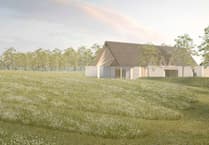It’s 80 years since the launch of the Women’s Timber Corps, a branch of the Women’s Land Army that worked in Britain’s forests during the Second World War.
As many as 15,000 to 18,000 young women left home for the first time, aged 17 to 24, to fell trees with an axe and saw for the war effort.
Doing what was thought to be ‘a man’s job’, these pioneering women brought gender stereotypes crashing down.
There were a dozen women who lived in Dockenfield and worked in Alice Holt Forest – one of whom was Joyce Elizabeth Gaster.
She joined the Women’s Land Army forestry section in 1940 in the Forest of Dean and trained as a measurer and later moved to Alice Holt Forest.
Joyce was one of the longest-standing members of the Women’s Timber Corps, receiving a badge for six years’ service on May 15, 1946. She also was one of the five women representing the Women’s Timber Corps in the victory parade in London on June 8, 1946.
Author Joanna Foat discovered the story of the corps while she worked for the Forestry Commission, now Forestry England, at Alice Holt Forest between 2010 and 2014.
She then spent two years interviewing 60 of these remarkable women, who became known affectionately as Lumberjills, and obtained unique first-hand accounts and evocative photographs of their lives in the forest.
While Joyce and many of these women have now died, their stories are told in Joanna’s book Lumberjills Britain’s Forgotten Army, an account of women’s forestry work during the war, published by The History Press.
The government at first refused to employ ‘the fairer sex,’ who they thought would be unable to cope with the tough work. Instead they tried to employ male British prisoners, male dockyard workers, male students and even school boys.
But thousands of members of the Women’s Land Army wanted to do their bit for the war like their brothers and the government’s position became untenable.
Joanna said: “I was shocked to discover how the women were treated at the beginning of the war.
“They were laughed at for their enthusiasm to offer their services, regarded as ornamental rather than useful and many timber merchants did not want women taking over the jobs of skilled men.
“In fact, the Lumberjills not only pioneered a new fashion for women in trousers, wearing jodphurs, but they also proved women could carry logs like weight-lifters, work in dangerous sawmills, drive huge timber trucks and calculate timber production figures on which the government depended during wartime.
“With their 80th anniversary, I hope to inspire women of all ages with the strength, courage and determination of the Lumberjills.
“Out in the forests away from the restrictions imposed on women by society, they realised they could sit astride a tree, smoke a pipe and fell ten-tonne trees just like the men, if they wanted to.’
Britain was the largest timber-importing nation in the world in 1939, importing 96 per cent of its wood. With the advent of war, home-grown timber supplies became vital. Britain needed to produce millions of tonnes of wood for pit props, railway sleepers, telegraph poles, gun butts, ships, aircraft, as well as packaging boxes for bombs and army supplies. Thousands of forestry workers were urgently required.
The term ‘Lumberjills’ was coined on April 18, 1942, when the Northern Daily Mail reported 25 Lancashire girls, former clerical workers, typists, and hairdressers, left Manchester for a timber training camp in the south east.
These young women had no idea what was ahead of them when the sign-up papers landed on the doormat. The hairdressers literally swapped scissors and comb for a 7lb axe and a 6ft crosscut saw.
In April 1942, Women’s Timber Corps training camps were set up across England: Culford near Bury, St Edmonds in Suffolk, and the Royal Ordinance Factory hostel near Wetherby in Yorkshire.
A month later, in May 1942, the Scottish Women Timber Corps established training camps: Shandford Lodge near Brechin in Angus and Park House, Drumoak in Aberdeenshire.
Hundreds of young women were trained at each camp in four lines of work: felling, haulage, sawmilling and measuring timber.
Many women rivalled the men in their strength and skill. One Scottish woman, Bella Nolan, challenged her foreman to a felling dual when he said he didn’t think much of the women. Each took one end of the cross cut saw and together they felled 120 trees in a day.
At the end of the war the Women’s Timber Corps received no recognition, grants or gratuities and the director of the Women’s Land Army, Lady Gertrude Denman, resigned in protest.
They were not allowed to keep their uniforms or attend Remembrance Day parades, because they were not part of the fighting forces.
The women went back into traditional roles of clerical and shop work, teaching, domestic service or got married.
More than 60 years later – when most of the women were in their 80s – the-then prime minister Gordon Brown finally presented them with a badge. But to their disappointment the badge bore a wheatsheaf, the emblem of the Women’s Land Army, not a pine tree or a pair of crossed axes.
Joanna added: “Many of the lumberjills I met were still upset that they remained a footnote to the Women’s Land Army, so I wanted to make sure they were remembered in history.
“Now their incredible feats of physical and mental endurance inspire women today, especially female forestry workers and arborists from across the world.
“Given the freedom and opportunity to work together in sisterhood out in the forest, naturally the lumberjills were a huge success.”
Lumberjills Britain’s Forgotten Army by Joanna Foat is published by the History Press. For further information visit www.thelumberjills.uk or https://www.thehistorypress.co.uk/publication/lumberjills/9780750990905/




